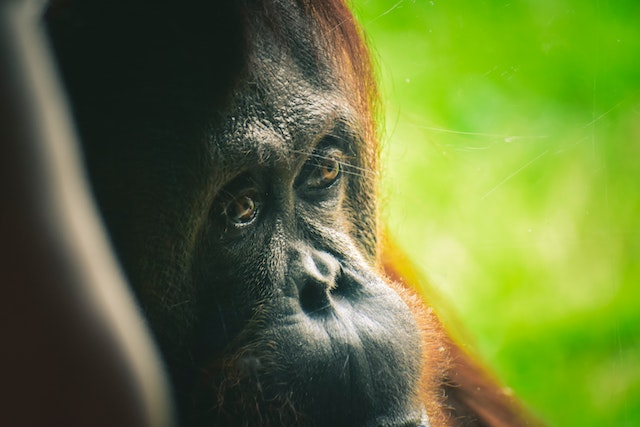While the Tanjung Puting National Park burned around her, wildlife worker and former lawyer Tess Armistad clicked her tongue and inched closer to a heap of burning debris.
Terrified eyes peered back at her. Buried inside the peat-land was a young orangutan displaced in the burning forest of the Kalimantan. The park — home to some 6000 red apes — had been set ablaze by planation workers in what began as a controlled fire to clear land for palm oil, that, mismanaged, had been burning recklessly for days. The workers had evacuated, leaving only a few volunteers from local rescue centers to extract accessible wildlife. As Amistad pulled the young ape to safety, set him upon her back and made her way out, she felt his grip become limp. His breathing stopped and there, in the heart of the palm oil fire, he succumbed to smoke inhalation and died.
Later, another palm oil fire would advance into the dense Borneo jungle and threaten a further one third of the world’s orangutan population. Satellite photography shows more than 100,000 forest fires have burned through carbon-rich orangutan habitat since July 2014, with several hundred to several thousand of those encroaching vulnerable ape populations.
Orangutans, both Bornean and Sumatran, are critically endangered, victims of a different kind of oil spill: the trade in palm oil.
Palm oil monoculture is palming off orangutans in record numbers. Today, less than 70,000 orangutans exist in small wild pockets in the rainforests of Borneo and Sumatra. Populations are patchy and lack diversity, with conversion of land for palm oil plantation believed to be the species’ biggest threat.
Today, the wealthy palm oil industry is again at the forefront of environmental news, with NGO’s calling for the boycott of palm oil giant IOI Group who controversially use palm oil tied to suppliers with links to tropical forest destruction. IOI are currently suing the Roundtable on Sustainable Palm Oil (RSPO) for cancelling its membership and suspending them from labelling their palm oil as “certified sustainable.” IOI failed to address complaints that their processing arm, IOI Lodgers Croklaan, had cleared forests and drained peatlands without a license.
Found in some 75% of every day products, palm oil (sometimes known as vegetable oil) is the edible oil derived from the fleshy middle layer of the fruit of the oil palm. It acts as a cooking agent and is a popular household ingredient. As of 2010, it was the most widely used edible oil in the world, holding approximately 32% of the world’s oil market. Palm oil is found universally in McDonalds, Cadbury chocolates, KFC packaging, Dove and Avon personal care products, Herbal Essence shampoo, Clinique cosmetics, Tim Tams, Kit-Kats and Malteasers, Ritz crackers, Colgate and Palmolive toothpaste, Mars Incorporated chocolates and in Mary Kay, Covergirl, Lancome, Sephora and Urban Decay cosmetics.
Scientists predict the average consumer uses at least one palm oil product per day.
Approximately 66% of Indonesia’s palm oil plantations and 87% of Malaysia’s plantations involved some form of forest conversion in order to urbanize for mass-agriculture, displacing orangutans, tigers, elephants and exotic birds, and disorienting their ability to find food and seek shelter. Since plantations are often close to villages, lost orangutans have begun to encroach on human settlement, and those results are fatal for wildlife.
In 2010, animal rights group International Animal Rescue recorded “unspeakable cruelty” toward orangutans in Peniraman, remote Borneo, after a female red ape and her baby wandered onto a plantation in search of food and water. Angry plantation workers hurled stones and waved sticks at the mother before binding the pair with rope and forcing their heads under the water. The mother later died.
The consumption of unsuitable palm oil has driven orangutans, tigers, elephants and other forest biodiversity toward extinction.
“I dread to think what it will mean for orangutans, clouded leopard and the iconic hornbill,” said Mark Harrison, the director of the research and conservation group Orangutan Tropical Peatland Project (OuTrop).
The dry peats set alight by palm oil plantation workers ignite easily and burn for days or weeks, smoldering underground and re-emerging far away from the original forest fire. Smoldered fires also produce high levels of harmful gases and particulates.
The WWF last year said there was no real reason for companies not be using 100% certified oil manufactured in factories and facilities.
Of the campaign, WWF said, “other big palm oil consumers such as Unilever, Ferrero, L’Oreal, Delhaize, Kellog and the world’s biggest palm oil trader, Wilmar International, have all committed to no deforestation.”
But to save the orangutan, consumer support is just as important.
According to conservationists and NGOs, the consumer role in protecting wildlife includes peeling back the label to look for products that read only “certified palm oil” and questioning products using vegetable oil without a particular clarification on its origin.
If it’s not NGO certified, palm it off.
~
Update: Some of the companies mentioned may have updated their palm oil certifications after the time of the original post, before published at Medium.com. Please refer to each company and their website for further information on their palm oil suppliers.
~
Ellie Sursara is a wildlife scientist, science teacher and higher degree research student at The University of Queensland. Her work explores the complex relationships between people and planet and the protection of local native habitat and biodiversity.
~
Editor: Bryonie Wise
Like elephant animals are people too on Facebook.











Read 7 comments and reply